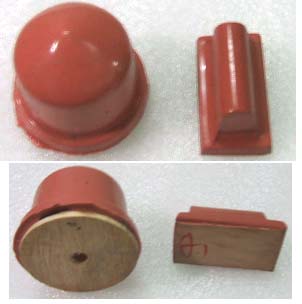Ink Well pad
printer making package:
Including:
1 Manual ink Well pad printer
1 Exposure machine
20 photopolymer plates ( 75mm x
100mm)
2 Pads
50 A4 size Transparent
films ( for injet
printer or laser priter uses ) |
Open inkwell
printer
Open ink well systems use a trough (ink
well) for the ink supply, located behind the printing plate. A flood bar
pushes a pool of ink over the plate, and a doctor blade removes the ink
from the plate surface, leaving ink on the etched artwork area ready
for the pad to pick up.
AD:blade is very cheap, waste ink,
Sealed ink cup
printer
Sealed ink cup systems employ a sealed
container (ink cup), which acts as the ink supply, flood bar and doctor
blade all in one. A ceramic ring with a highly polished working edge
provides the seal against the printing plate.
AD: ceramic ring is expensive, save ink.
|
Advantages of Photopolymer Plates making:
1. Good for the environment,
no need chemicals.
2.Make clich making process easier to operate.
3.Save money for you, no need of chemicals and no steel coating
machine. |
Photopolymer Plates
The plate material is UV photosensitive and when
exposed to an ultraviolet light through a high contrast negative, the
U.V. cross links the polymers and hardens the image.
The unexposed portion of the negative is washed
off in plain water, dried and post exposed. the plate is ready for the press in less than thirty
minutes. |
1:Pad
Printer (Inkwell) ONE Unit
TECHNICAL
PARAMETER: Max printing area 80×80mm
Steel plate size 100×100mm
Max workpiece length 150mm
Level stroke 100mm
Pad vertical distance 60mm
Printing speed 400pcs/hr
Out dimension 400×200×500mm
Machine net weight 27kg
Free two pads

|
|
2:UV Exposure Unit : ONE Unit
Main features:
User-friendly desktop design with long-term life span
Parameters.
6 UV fluorescent tubes
Exposing area: 10.23"x8.26"(260x210mm)
Voltage: 110v/220v
Light power: 48W (8W x 6 tubes)
Time Range: 0-5.5 mins
Machine size:11.82"x11.8"x29.5"(30x29x75cm)
Net weight: 12Lb(5kg)
|
|
|
3:Polymer plates: 20
sheets
Size: 75mm x
100 mm(for our ink well pad printer )
If you need more, can buy from our store:
- Providing a good do-it-yourself
option. These are typically used in short to medium production runs.
- Water washable No
solvent used!!
- High durability,
Allows printing very fine lines and big solid lines together, by using
300 lpi screen available.
- High Reproductivity
- Cost Effective
|
|
|
4:Transparent films: 20 SHEETS
( for ink-jet printer or laser priter uses )
If you need more, can buy
from our store:
Any Epson、HP、Canon ink-jets
printers can use it.
This Film is a specially coated,clear film that absorbs quick
drying inkjet ink, and controls the shape of fine lines and half
tones,can be used to make stencil in screen printng,hot stamping and pad
printing.Ink-jets achieve better quality.
Print on the coated (matte) side of the film!
For the unique high-tech solution, they can not be conglutinated with
each other when folded together. The image is well-resisting and
suitable for storage.
Note 1: This film also can be used in your laser printer
Note 2: Your wet finger will stick to the coated side.
Note 3: Printing side is the non-smooth side
A4 8"x12" (210x297 mm) |
|
Polymer
plates Pad Printing Plate Making Process |
 |
1.Contact
with Positive film
Remove cover film slowly and place positive film onto
undeveloped plate.
Use positive film having optical density of not
less than 3.0.
|
 |
2.Exposure
Expose plate, through positive film, to UV light
having 360 nm wave lengths for 1-2 minutes.
|
 |
3.Contact
with screen film
Remove positive film and place screen film on undeveloped plate.
240
and 300 lpi screen films are available and are supplied by our
distributor in your country. |
 |
4.Exposure
Expose plate, through screen film, to UV light having
360 nm wave lengths, for 5-6 minutes.
Give longer exposure time, if
shallower cell depth is required.
|
 |
5.Wash-out
Remove screen film.
Wash-out exposed plate with
water, at 15-25 for 0.5-2 minutes. for 0.5-2 minutes.
If wash out
unit is not available, you can wash it out with running tap water.
|
 |
6.Drying
Dry the plate in a hot-air dryer after removing the
surface water by sponge roll or compressed air at 50-70 for 5-10 minutes. for 5-10 minutes.
|
 |
7.Post
exposure
Expose the dried plate to UV light again for 5-10
minutes in order to get stability.
|
General Hints:
- Gloss
film as well as matted film can be used.
- Good
contact between film and plate is essential.
- Treat
films carefully as any kink will be reproduced on the developed plate.
- Check
film and plate without any dust before exposure.
- Minimize
the pressure of doctor blade to enjoy longer durability of plate.
- It
can be used in inkwell system and closed ink cup system.
|
|
Important notes about making printing plates:
* The first exposure time on the
film positive determines the overall depth of the ink well. The SHORTER
the exposure time the deeper the printing plate.
* The second exposure on the film positive determines the amount of
ink, the size of the dot and the spacing between the dots.
* Reducing the 2nd exposure time on the screen will reduce the height
of the dot and will let more ink transfer
* You can control the printing effects by varying halftone screens:
|



